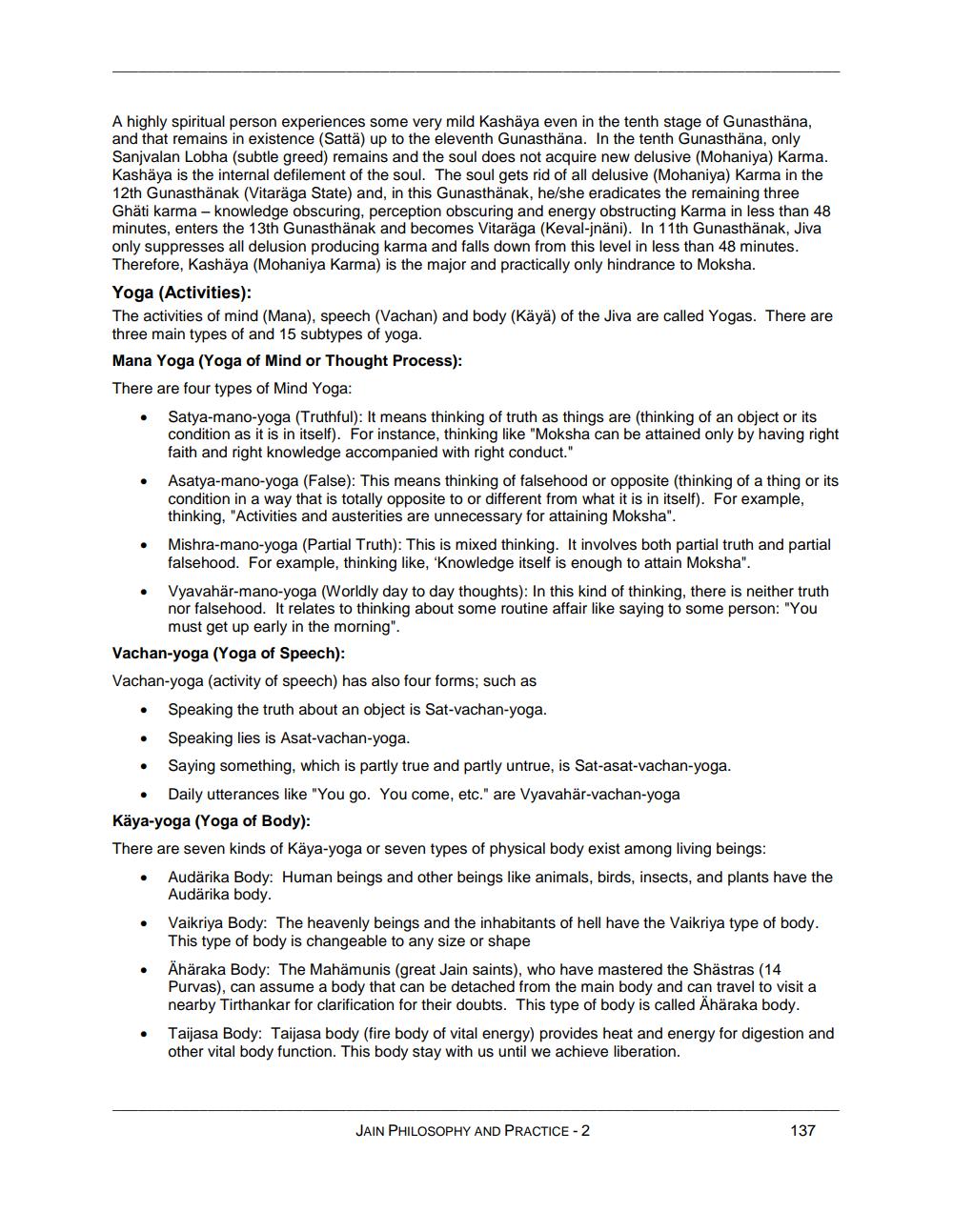________________
A highly spiritual person experiences some very mild Kashaya even in the tenth stage of Gunasthana, and that remains in existence (Sattä) up to the eleventh Gunasthana. In the tenth Gunasthäna, only Sanjvalan Lobha (subtle greed) remains and the soul does not acquire new delusive (Mohaniya) Karma. Kashaya is the internal defilement of the soul. The soul gets rid of all delusive (Mohaniya) Karma in the 12th Gunasthänak (Vitaräga State) and, in this Gunasthänak, he/she eradicates the remaining three Ghäti karma - knowledge obscuring, perception obscuring and energy obstructing Karma in less than 48 minutes, enters the 13th Gunasthänak and becomes Vitaraga (Keval-jnäni). In 11th Gunasthänak, Jiva only suppresses all delusion producing karma and falls down from this level in less than 48 minutes. Therefore, Kashäya (Mohaniya Karma) is the major and practically only hindrance to Moksha. Yoga (Activities): The activities of mind (Mana), speech (Vachan) and body (Käyä) of the Jiva are called Yogas. There are three main types of and 15 subtypes of yoga. Mana Yoga (Yoga of Mind or Thought Process): There are four types of Mind Yoga:
Satya-mano-yoga (Truthful): It means thinking of truth as things are thinking of an object or its condition as it is in itself). For instance, thinking like "Moksha can be attained only by having right faith and right knowledge accompanied with right conduct." Asatya-mano-yoga (False): This means thinking of falsehood or opposite (thinking of a thing or its condition in a way that is totally opposite to or different from what it is in itself). For example, thinking, "Activities and austerities are unnecessary for attaining Moksha". Mishra-mano-yoga (Partial Truth): This is mixed thinking. It involves both partial truth and partial falsehood. For example, thinking like, 'Knowledge itself is enough to attain Moksha". Vyavahär-mano-yoga (Worldly day to day thoughts): In this kind of thinking, there is neither truth nor falsehood. It relates to thinking about some routine affair like saying to some person: "You
must get up early in the morning". Vachan-yoga (Yoga of Speech): Vachan-yoga (activity of speech) has also four forms; such as • Speaking the truth about an object is Sat-vachan-yoga.
Speaking lies is Asat-vachan-yoga.
Saying something, which is partly true and partly untrue, is Sat-asat-vachan-yoga. • Daily utterances like "You go. You come, etc." are Vyavahär-vachan-yoga Käya-yoga (Yoga of Body): There are seven kinds of Käya-yoga or seven types of physical body exist among living beings:
Audärika Body: Human beings and other beings like animals, birds, insects, and plants have the Audärika body. Vaikriya Body: The heavenly beings and the inhabitants of hell have the Vaikriya type of body. This type of body is changeable to any size or shape Ähäraka Body: The Mahämunis (great Jain saints), who have mastered the Shästras (14 Purvas), can assume a body that can be detached from the main body and can travel to visit a nearby Tirthankar for clarification for their doubts. This type of body is called Ahäraka body. Taijasa Body: Taijasa body (fire body of vital energy) provides heat and energy for digestion and other vital body function. This body stay with us until we achieve liberation.
JAIN PHILOSOPHY AND PRACTICE -2
137




